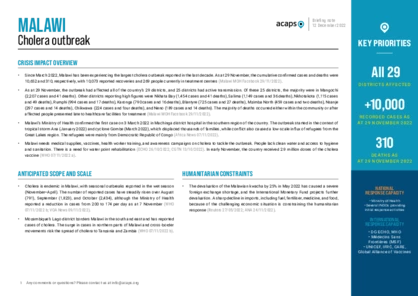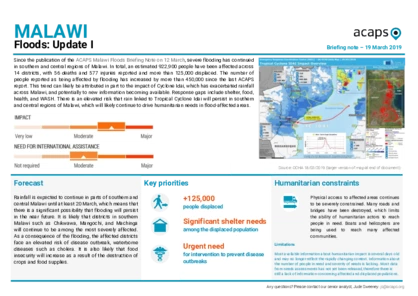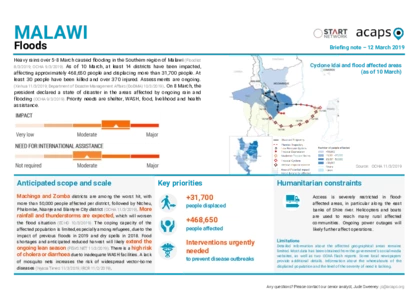Latest updates on country situation
01 April 2025
Given reduced funding, WFP may halt assistance to refugees and asylum seekers in Dzaleka refugee camp, the main refugee camp in Malawi, after May 2025. Since February, the funding decline has already led to WFP previously reducing food rations from 75% to 50%. In the same month, WFP assisted approximately 57,000 refugees and asylum seekers in the camp, which was designed to accommodate a maximum of 15,000 people. Such overcrowding strains already limited resources and increases the risk of communicable diseases spreading. Access to livelihoods is also highly limited, in large part because of Malawi's encampment policy and restrictions on refugee employment. Only 30% of the camp's population engages in economic activities, leaving many vulnerable. The majority are from the Democratic Republic of Congo, followed by individuals from Burundi and Rwanda, who fled to Malawi with already high needs for food, protection, livelihoods, healthcare, and education. (The Times Group 31/03/2025, Radar Africa 28/03/2025, AfricaBrief 29/03/2025)
18 March 2025
From 10–12 March 2025, Cyclone Jude hit southern Malawi, affecting over 20,000 and displacing over 4,000. By 18 March, those displaced were staying in eight temporary shelters. The cyclone caused flooding in nine southern councils, with Phalombe district being the worst affected. The affected people require shelter, food, NFIs, and healthcare assistance. (OCHA 18/03/2024)
07 January 2025
Mozambique has been experiencing a significant rise in political violence, especially riots and protests, since the disputed general election held in October 2024. Post-election violence has led to hundreds of fatalities in the country and thousands of cross-border displacements, mostly to Malawi. Up until 6 January 2025, around 13,000 people have fled to Malawi, escaping attacks and looting. Many have walked hundreds of kilometres and crossed waterways on foot or by small boats. Most of the displaced are residing in overcrowded makeshift shelters and lack access to adequate WASH facilities. In some displacement sites, around 1,000 people are sharing a single latrine, which significantly increases the risk of disease spread. The displaced urgently need food, potable water, shelter, access to WASH facilities and healthcare, hygiene kits, and household items such as blankets. Humanitarian assistance is being provided, but significant gaps remain. (UNHCR 31/12/2024, RFI 06/01/2025, ACLED accessed 08/01/2025)
17 December 2024
Tropical Cyclone Chido caused significant disruption in the Comoros, Malawi, Mayotte and Mozambique. In Mozambique, it made landfall on 15 December 2024 in Cabo Delgado province, killing at least 45, injuring 493, and affecting over 184,000 people. It damaged approximately 35,000 houses, 149 schools, and 48 health facilities, mostly in Chiure, Mecufi, and Pemba, which are facing utility outages and urgent protection needs. In Malawi, it had affected over 45,000 people across 16 districts by 18 December, with 13 fatalities and infrastructure damage. Heavy rains continue to threaten the population. In the Comoros, it hit Anjouan and Moheli, affecting over 64,000 residents, displacing about 140, and injuring five. It damaged over 218 houses, nine schools, and 45% of crops, with reports of landslides and strong winds. Across all regions, urgent needs include shelter, food, infrastructure repair, and risk mitigation. Access issues and rainfall hamper recovery efforts. (OCHA 17/12/2024, OCHA 18/12/2024, OCHA 16/12/2024)
24 September 2024
In 2024, southern Africa is experiencing its worst drought in 100 years as a result of El Niño. Approximately 61 million people need assistance, with over 20 million experiencing Crisis (IPC Phase 3) food insecurity levels. Botswana, Lesotho, Malawi, Namibia, Zambia, and Zimbabwe have declared a state of emergency in response to the severe drought. There has also been a significant increase in malnutrition cases in Angola, Madagascar, Malawi, Mozambique, and Zambia, with expectations for the trend to continue into the first quarter of 2025. (OCHA 20/09/2024, OCHA 19/09/2024)
15 July 2024
In Malawi, approximately 5.7 million people (28% of the population assessed) are expected to face Crisis (IPC Phase 3) or worse food insecurity from October 2024 to March 2025, with 416,000 likely facing Emergency (IPC Phase 4) conditions mainly because of inflation, economic slowdown, and the droughts and floods resulting from El Niño. 2024 records a five-year high of 5,692,122 people expected to face acute food insecurity during the October–March projection period, which aligns with the typical lean season. In March 2024, Malawi declared a state of disaster in 23 districts in response to the prolonged dry spells and floods experienced between October 2023 and March 2024. These conditions affected harvests, with the 2024 maize production reported in July to have dropped by 17% compared to the previous season (to 2.9 million MT from 3.5 million MT). Urgent needs include food and nutritional assistance. (IPC 05/07/2024, Malawi 24 23/03/2024, Nyasa Times 05/07/2024)
26 March 2024
On 23 March 2024, the President of Malawi declared a state of disaster in 23 of the country's 28 districts in response to food insecurity aggravated by El Niño. The effects of the phenomenon (insufficient rainfall, floods, and prolonged dry spells) have resulted in farmland damage, leading the Government to make the declaration. Between October 2023 and March 2024, 4.4 million people were projected to face Crisis (IPC Phase 3) or worse food insecurity levels. The numbers may increase in the coming months, as two million farming households have been affected and 44.3% of national cropland has suffered damage. The most pressing need in all affected districts is food. (Malawi Voice 23/03/2024, MENAFN 24/03/2024, OCHA/RIASCO 12/03/2024)
current crises
in
Malawi
These crises have been identified through the INFORM Severity Index, a tool for measuring and comparing the severity of humanitarian crises globally.
MWI002 - Complex
Last updated 28/03/2025
Drivers
Drought
Socio-political
Cyclone
Crisis level
Country
Severity level
3.4 High
Access constraints
1.0
Analysis products
on
Malawi
12 December 2022
Malawi: cholera outbreak
DOCUMENT / PDF / 403 KB
Since March 2022, Malawi has been experiencing the largest cholera outbreak reported in the last decade. Malawi needs medical supplies, vaccines, health worker training, and awareness campaigns on cholera to tackle the outbreak. People lack clean water and access to hygiene and sanitation.
19 March 2019
Malawi: Floods, Update I
DOCUMENT / PDF / 386 KB
Since our last publication, severe flooding has continued in southern and central regions of Malawi. In total, an estimated 922,900 people have been affected across 14 districts, with 56 deaths and 577 injuries reported and more than 125,000 displaced.





